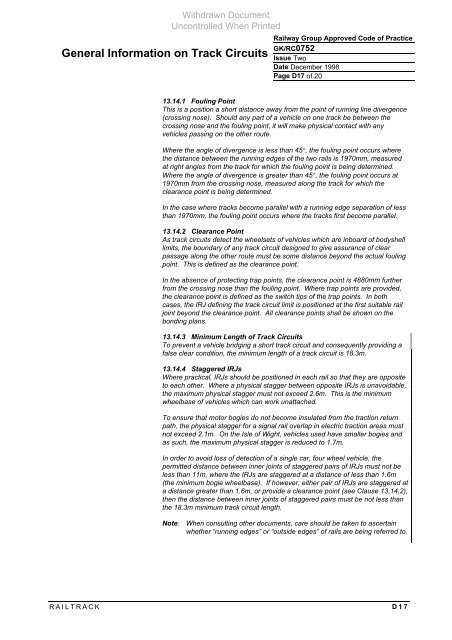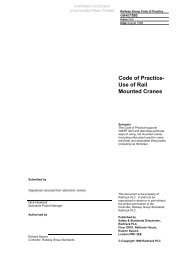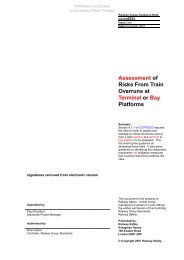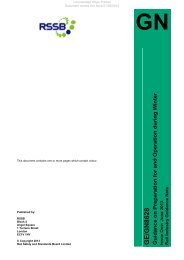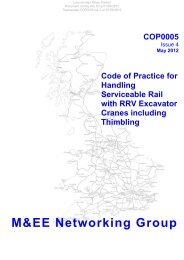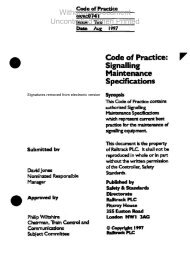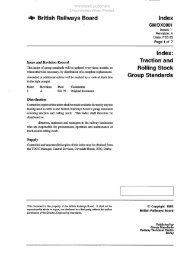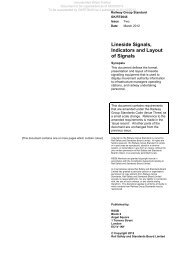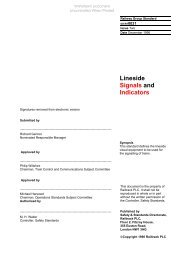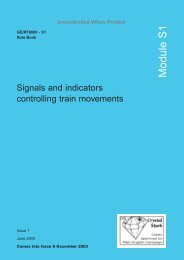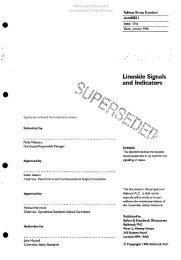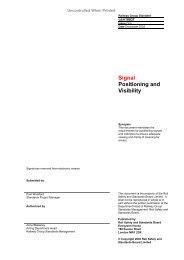General Information on Track Circuits - RGS Online
General Information on Track Circuits - RGS Online
General Information on Track Circuits - RGS Online
You also want an ePaper? Increase the reach of your titles
YUMPU automatically turns print PDFs into web optimized ePapers that Google loves.
Withdrawn Document<br />
Unc<strong>on</strong>trolled When Printed<br />
<str<strong>on</strong>g>General</str<strong>on</strong>g> <str<strong>on</strong>g>Informati<strong>on</strong></str<strong>on</strong>g> <strong>on</strong> <strong>Track</strong> <strong>Circuits</strong><br />
Railway Group Approved Code of Practice<br />
GK/RC0752<br />
Issue Two<br />
Date December 1998<br />
Page D17 of 20<br />
13.14.1 Fouling Point<br />
This is a positi<strong>on</strong> a short distance away from the point of running line divergence<br />
(crossing nose). Should any part of a vehicle <strong>on</strong> <strong>on</strong>e track be between the<br />
crossing nose and the fouling point, it will make physical c<strong>on</strong>tact with any<br />
vehicles passing <strong>on</strong> the other route.<br />
Where the angle of divergence is less than 45°, the fouling point occurs where<br />
the distance between the running edges of the two rails is 1970mm, measured<br />
at right angles from the track for which the fouling point is being determined.<br />
Where the angle of divergence is greater than 45°, the fouling point occurs at<br />
1970mm from the crossing nose, measured al<strong>on</strong>g the track for which the<br />
clearance point is being determined.<br />
In the case where tracks become parallel with a running edge separati<strong>on</strong> of less<br />
than 1970mm, the fouling point occurs where the tracks first become parallel.<br />
13.14.2 Clearance Point<br />
As track circuits detect the wheelsets of vehicles which are inboard of bodyshell<br />
limits, the boundary of any track circuit designed to give assurance of clear<br />
passage al<strong>on</strong>g the other route must be some distance bey<strong>on</strong>d the actual fouling<br />
point. This is defined as the clearance point.<br />
In the absence of protecting trap points, the clearance point is 4880mm further<br />
from the crossing nose than the fouling point. Where trap points are provided,<br />
the clearance point is defined as the switch tips of the trap points. In both<br />
cases, the IRJ defining the track circuit limit is positi<strong>on</strong>ed at the first suitable rail<br />
joint bey<strong>on</strong>d the clearance point. All clearance points shall be shown <strong>on</strong> the<br />
b<strong>on</strong>ding plans.<br />
13.14.3 Minimum Length of <strong>Track</strong> <strong>Circuits</strong><br />
To prevent a vehicle bridging a short track circuit and c<strong>on</strong>sequently providing a<br />
false clear c<strong>on</strong>diti<strong>on</strong>, the minimum length of a track circuit is 18.3m.<br />
13.14.4 Staggered IRJs<br />
Where practical, IRJs should be positi<strong>on</strong>ed in each rail so that they are opposite<br />
to each other. Where a physical stagger between opposite IRJs is unavoidable,<br />
the maximum physical stagger must not exceed 2.6m. This is the minimum<br />
wheelbase of vehicles which can work unattached.<br />
To ensure that motor bogies do not become insulated from the tracti<strong>on</strong> return<br />
path, the physical stagger for a signal rail overlap in electric tracti<strong>on</strong> areas must<br />
not exceed 2.1m. On the Isle of Wight, vehicles used have smaller bogies and<br />
as such, the maximum physical stagger is reduced to 1.7m.<br />
In order to avoid loss of detecti<strong>on</strong> of a single car, four wheel vehicle, the<br />
permitted distance between inner joints of staggered pairs of IRJs must not be<br />
less than 11m, where the IRJs are staggered at a distance of less than 1.6m<br />
(the minimum bogie wheelbase). If however, either pair of IRJs are staggered at<br />
a distance greater than 1.6m, or provide a clearance point (see Clause 13.14.2),<br />
then the distance between inner joints of staggered pairs must be not less than<br />
the 18.3m minimum track circuit length.<br />
Note: When c<strong>on</strong>sulting other documents, care should be taken to ascertain<br />
whether “running edges” or “outside edges” of rails are being referred to.<br />
RAILTRACK D17


